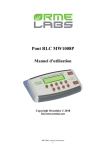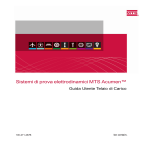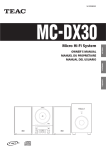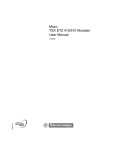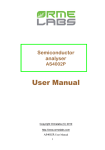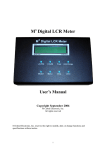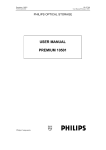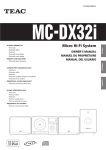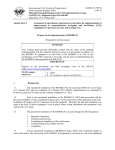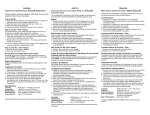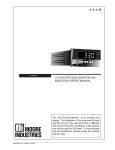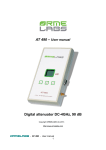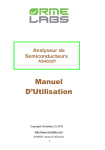Download Notice MW1008P en
Transcript
RLC bridge MW1008P User Manual Copyright Ormelabs © 2010 http://www.ormelabs.com MW1008P, user manual 1 Table of contents Page 5 5 6 7 7 General Information Specifications Terms and symbols Prefixes of measurement units Glossary Generalities Display Keypad 9 10 Operation Passive Components Displayed parameters Polarisation of electrochemical capacitors Polarisation of coils Measurement of batteries impedance Components sorting Serial and Parallel models Displays types Test conditions Test frequencies Impedances ranges Open-short calibration Connecting to a passive component Connecting to a transformer Pinout of DUT connector 14 15 17 18 18 20 21 21 23 23 25 25 27 27 28 Precision Precision of resistances/impedances Precision of inductances Precision of capacitors 29 30 30 Theory of operation Signal generator Phase detector and analog/digital converter Transformers 29 30 30 Calibration Parameterizing the calibration Calibration Error messages 32 33 34 Diagnostics Keyboard test Buzzer test i/v complex A/D results 35 36 36 37 MW1008P, user manual 2 MW1008P, user manual 3 GENERAL INFORMATIONS The MW1008P LCR Meter is a multi-frequency impedance measuring instrument capable of measuring resistance, capacitance, inductance or transformer parameters from 1 mΩ to 100 MΩ. The MW1008P LCR meter has a basic accuracy of 0.2% and has 11 test frequencies plus one user definable. The LCR meter is controlled by a high-speed micro-controller with embedded logic that controls the display and keypad, as well as setting measurement conditions and performing calculations. Please refer to chapter “Operation” for more details about instrument operation. SPECIFICATIONS: Auto, L+Q, C+D, R+Q, |Z|+θ, R+X, G+B, N+θ, N-1+θ ,Vs+Vp, M, L+AL, C+Vr (varactor option) Equivalent circuit Series or parallel Displayed parameters Value, Deviation, % deviation Measurement display L+Q: L 0,01 µH – 99,99 H Q 0,0001 – 100 C+D: C 0,001 pF – 99999 µF D 0,0001 – 10 R+Q: R 1 mΩ – 99,9 MΩ Q 0,001 – 100 |Z|+θ: |Z| 1 mΩ – 99,9 MΩ θ -180,00° - +180,00° R+X: R 1 mΩ – 99,9 MΩ X 1 mΩ – 99,9 MΩ G+B: G B N+θ: N 1 – 9999 θ -180,00° - +180,00° N-1+θ N-1 0.0001 – 1 θ -180,00° - +180,00° Vs+Vp Vs 230V/N or 115V/N, resolution 0,01V Vp 115V or 230V M M 0,01 µH – 99,99 H L+AL L 0,01 µH – 99,99 H AL L/N2 (N user definable from 1 to 999) Functions with varactor adapter MW108 : C+Vr C Vr 0,001 pF – 99999 µF 0,00-5,0V or 0,0 – 28,0V Test conditions : Test frequencies Test voltage 100 Hz, 120 Hz, 250 Hz, 500 Hz, 1 kHz, 2,5 kHz, 5 kHz, 7,8125 kHz, 12,5 kHz, 15,625 kHz, 25 kHz 0,5 Vrms ±10% (no load) MW1008P, user manual 4 Measurement rate Ranging 2 measures per second (without averaging) Auto or manual Precision : Conditions Base precision At least 15 minutes warm-up, 23 °C ± 5 °C ±0,2 % (15Ω ≤ |Z| ≤ 300kΩ et f ≤ 1kHz) See the accuracy section for detailed accuracy specifications Various: Fixture: 4 wires Kelvin on CB connector Protection Protected up to 1 Joule of stored energy, 100 VDC max (for charged capacitors) open/short circuit compensation Zeroing Compensation limits Short: R < 20 Ω |Z| < 50 Ω Open: |Z| > 10 kΩ Sorting Selection of tolerance (1,2,5,10 or 20%) Averaging 2 to 8 measurements General: Operating Conditions 0 – 50 °C, < 80% relative humidity Power supply 7.5 – 15V, 150 mA with light, <100 mA without Dimensions 6.125 in × 1.5 in × 3.875 in (W x H x L) Options: MW108 MW10 MW-KELV MW-SMT Varactor adapter Universal 4 wires Kelvin cable (mini-pincers) Kelvin pincers cable SMT cable TERMS AND SYMBOLS Parameter Z Y |Z| Rs or ESR X G B Measurement Complex impedance Admittance, 1/Z Impedance module Z Serial resistance, Real part of impedance Reactance, imaginary part of impedance Conductance, Real part of admittance (Y) Susceptance, MW1008P, user manual 5 Unit symbol ohm, Ω Siemens, S ohm, Ω ohm, Ω ohm, Ω siemens, S siemens, S Imaginary par of admittance Series capacitance Parallel capacitance Series Inductance Parallel Inductance Parallel Resistance Quality factor Dissipation factor Phase angle of |Z| Mutual inductance Turns ratio Primary voltage (transformer) Secondary voltage (transformer) Cs Cp Ls Lp Rp Q D θ M N Vp Vs Farad, F Farad, F Henry, H Henry, H ohm, Ω none none Degree Henry, H none AC Volts, V AC Volts, V PREFIXES OF MEASUREMENT UNITS Multiplier Scientific Ingineer Symbol 1000000 1000 0,001 0,000001 0,000000001 0,000000000001 106 106 10-3 10-6 10-9 10-12 Mega Kilo milli micro nano pico M k m µ n p GLOSSARY Coil : A coil is made of several turns of insulated wire. The property of a coil is to oppose itself to current variations and is characterized by its inductance. Capacity : The property of a capacitor. The capacity of a capacitor is expressed in Farad (F). Capacitor: Passive component made of two plates separated by a dielectric. The property of a capacitor is to pass ac current while stopping dc current. See also capacity and reactance. Test frequency : The frequency in which the parameters of a component are measured. The parameter values depends generally upon frequency. Range: Impedance ranges that the instrument uses to perform measurements. Impedance : Complex value characterizing a passive component. The impedance has a real component (résistance) in series with an imaginary component (reactance). A pure resistance doesn’t have reactance while pure coils and capacitors doesn’t have resistance. MW1008P, user manual 6 Inductance : A property of a coil by which an electromotive force is induced in it by a variation of. The inductance of a coil is expressed in Henry (H). Parameter : Electrical property measured. The main parameter is the most important parameter of the component (capacity, inductance, resistance). The secondary parameter has less importance and characterizes component losses (quality factor, dissipation factor or phase angle). Accuracy : Difference between the measured value and the real value of a component. Accuracy is expressed as a percentage for the main parameter. The accuracy depends on the impedance and the test frequency. Generally the secondary parameter accuracy is an absolute value. Basic Accuracy : The actual accuracy of the instruments depends of some parameters like test frequency and impedance. The basic accuracy is the best-case accuracy that can be expected, this means 1 kHz test frequency and impedance between 10 Ω and 100 kΩ. Source Resistance: Output resistance of the test signal generator. The DUT is connected to the signal generator trough this resistor. The source Resistance depends on the impedance range. Resolution : Resolution is the smallest quantity that the instrument can display. Do not confuse this value with accuracy. Test Voltage : This is the rms value delivered from the instrument with no load for creating a current through the device under test. The source resistor as well as the actual DUT impedance imply that actual voltage across the DUT is always below this value. MW1008P, user manual 7 GENERALITIES This chapter gives an overview of the MW1008O characteristics. For further informations please refer to the operation section. DISPLAY The two lines of the LCD show measured values, selected parameters, instrument status and various messages. When making normal measurements, the major parameter (L, C, R, | Z|, G) is shown on the top line and the appropriate minor parameter (Q, D, X, θ, B), is shown on the bottom line. The number of displayed digits and the location of the decimal point are automatically adjusted according to the range and resolution. The Δ symbol in front of the major parameter indicates that the measurement is displayed as a relative or absolute deviation from a nominal value. A dark arrow present in the top left of the display indicates the unit is in the Auto Parameter mode. If a dark arrow is displayed in the bottom left of the LCD, the unit is in the Auto Model mode. The Range is indicated at the top right of the display. The ‘A’ character behind the Range number indicates that the instrument is in auto range mode. In Manual or Hold ranging mode, this letter becomes a blinking “H” character. The selected test frequency is displayed on the bottom right of the display. The word « USER » is displayed when the user frequency is selected. MW1008P, user manual 8 KEYPAD The keypad is used to select measurement conditions and to enter values. All keys have two functions, depending on whether the key is pressed momentarily or for two seconds or longer. L/C/R This key selects the parameter being measured. Pressing the L/C/R key steps through the major parameters to manually select the desired ([L+Q] or [L+AL], [C+D], [R+Q], [|Z|+θ], [R+X], [G+B]). When this key is pressed for more than two seconds the instrument goes in Auto Parameter mode. In this mode, the instrument will select the most appropriate parameter pair according to the phase angle and the absolute impedance. This mode is indicated by the presence of a dark arrow at the top left of the display. The different modes are described below. The [L+AL] mode replaces the [L+Q] mode when the instrument is configured in AL mode (see key MENU ). n/Vs/M This key selects the transformer measurement mode. Pressing this key steps through and permits the selection of the desired function ( [N+θ], [1/N+θ], [Vs+Vp], [M+θ] ). [N+θ] [1/N+θ] [Vs+Vp] [M+θ] Turns ratio and phase angle Reciprocal turns ratio and phase angle Secondary and Primary Voltage Mutual Inductance and phase angle Frequ. The Frequ. key selects one of the following test frequencies: 100 Hz, 120 Hz, 250 Hz, 500 Hz, 1 kHz, 2.5 kHz, 5 kHz, 7.8125 kHz, 12.5 kHz, 15.625 kHz and 25 kHz. The selected frequency is indicated just above this key. When the user frequency is selected the word USER is displayed. Pressing this key for longer than two seconds sets the LCR meter to use the default parameters. The default frequency is 1KHz. Hold/Range The Hold/Range key selects the impedance range of measurement appropriate for the device under test. Pressing this key holds the unit in its current measurement range. Repeated pressing of this key changes the measurement impedance range (1 – 6). Pressing this key for longer than two seconds returns the unit to auto-ranging or normal mode. The range is displayed in the top right corner of the display. The ‘A’ character behind the Range number indicates that the instrument is in Auto Range mode. In Manual or Hold ranging mode, this letter becomes a blinking “H” character. Pressing this key for two seconds or longer returns to MW1008P, user manual 9 the Auto mode. See also chapter “Impedance ranges” page 24 for more details about impedance ranges. MODEL The MODEL key selects between a series or parallel equivalent circuit model for the device under test. Pressing this key for two seconds or longer places the Model selection in Auto mode. In this case the instrument selects the most appropriate model. MENU The MENU key allows access to a series of special configurable parameters. Pressing this key displays the programmable options. The current state of each option is displayed on the first line of the LCD as that option is selected. To move through the Menu, press the key under the forward or back arrows displayed on the LCD. Menu Backlight Sound Averaging Numb. Avrg. Varactor (varicap) Usr f (user frequency) Sorting Default value Purpose ON The backlight can be set to ON or OFF. To turn the backlight off, press the key under OFF. ON This option turns the audible alert function ON or OFF. ON Set this feature to ON to compensate for random noise that is apparent when measuring some components. There are seven selectable step rates from 2 to 8. Each step adds approximately .25 seconds to the sampling refresh rate of the LCD display. 4 OFF 1.25 kHz OFF Number of measurements used for avaeraging. This option requires the MW108 Varactor Test Fixture available from MW Instruments. Turning the Varactor option to ON will place the LCR meter automatically in the Varactor measurement mode upon saving and exiting the Menu. To return to normal features, select the Menu key and turn the Varactor feature OFF. Set the user frequency from 100 Hz up to 25 kHz Use this feature to measure and sort like valued components. • Turning the Sorting function ON will allow the user to set the Tolerance between the value of the benchmark component and like components to be measures. This Tolerance is selected by pressing the NEXT key. • When the appropriate tolerance has been selected, pressing the key under the left arrow enables the value of the benchmark component to be entered by MW1008P, user manual 10 pressing the ‘Edit’ key. A cursor will appear under the first digit of the value. Pressing the NEXT key will move the cursor to the next digit. Pressing the ‘Change’ key will step the value of the selected digit. When the desired value has been entered, pressing the OK key will record this value. • Pressing the key under the right arrow will allow the user to set the audible indication when a DUT meets the programmed parameters. Default value for the Pass Beep is SHORT. Pressing the NEXT key will change the value to LONG or NONE. • Pressing the key under the right arrow will present the option of turning the backlight on or off when a valid component is measured. The default value is YES. • Pressing the Menu key now will allow you to save the selected configuration and place the LCR meter in the Relative measurement mode. • To turn the Sorting mode OFF, press the Menu key and step backward or forward using the appropriate arrow key until the Sorting option is displayed. Press the key under OFF. Press the Menu key and save this configuration. AL measurement OFF Set this feature to ON to measure the AL value of an unknown toroid core. Press the ‘forward arrow’ key to enter the number of turns on the inductor. To enter the number of turns, select EDIT. A cursor will be displayed under the last digit on the LCD. Pressing the Change key will step the value of the digit over the cursor. Pressing the NEXT key will move the cursor to the far left position. When the number of turns has been entered, press the OK key. For accuracy, a minimum of 10 evenly distributed turns on the core is recommended. 1. Pressing the Menu key and saving the current configuration will place the LCR meter in L+ AL mode. The AL value will be displayed on the second line of the display. 2. To return to normal measurements, press the Menu key and step backward or forward using the appropriate arrow key to the AL display option. Select OFF and press the Menu key again. Save the current configuration. MW1008P, user manual 11 DISP. The DISP. key selects the manner that the value of a component will be displayed. If the Sorting mode is disabled, pressing DISP. cycles through the following display types: · The value being measured · The deviation of the value from the current value – The D symbol next to the measured parameter indicates that this function is active. · The percent of deviation from the current value - The D symbol next to the measured parameter indicates that this function is active. In Sorting Mode pressing DISP. cycles through the following display types: · The value being measured · The percent of deviation from a stored value - The D symbol next to the measured parameter indicates that this function is active. In this mode, a PASS/FAIL message is shown in the second line of the display according to the measured deviation and the selected tolerance. CAL The CAL key allows access to open/short compensation. Pressing the CAL key displays the zeroing options on the second line of the LCD – Open Short Exit. This option will zero the LCR meter for the currently selected test frequency. Pressing the CAL key for more than two seconds displays the zeroing options – OPEN SHORT Exit (note that the options are in all capital letters). This option performs an open/short calibration through the entire range of test frequencies. MW1008P, user manual 12 OPERATING POWER ON THE INSTRUMENT The instrument can be powered either by a 9V battery or by an external power supply. In this last case the power supply must be well filtered and its voltage must lie between 8 and 15V. Consumption is 150mA approximately when the backlight is activated. In the case of battery use a warning message is displayed when the voltage is below 7V. In this case the backlight is automatically deactivated. Besides we advise you not to use lighting when the instrument is supplied by battery, which makes it possible to divide by two the consumption of the instrument. The battery replacement requires the opening of the battery compartment. PASSIVE COMPONENTS FORME GENERALE Rp All non-ideal passive component (resistor, capacitor or inductor) can be represented by a real part (the resistance) in series or in parallel with an imaginary part (reactance, inductance if positive or capacitance if negative). The impedance varies with frequency. The series or parallel model are equivalent at a given frequency and one can goes from one model to the other one thanks to the equations below. Generally one model is more appropriate than the other one in a given measurement conditions, that is to say when the series or parallel resistance represent a physical property of the part. Temperature can have a large impact on the DUT impedance. Usually, capacitors have large temperature coefficients except for ceramic COG/NPO capacitors, which can exhibit only a 0.003%/°C variation. Inductors, especially those with non-air cores, may vary largely with temperature. Ambient and DUT temperature drifts may introduce error into the measurement. Control ambient temperature changes to reduce errors. Xs Rs Xp Q= D= Xs Q= Rs Rs D= Xs Rp Xp Xp Rp CONDENSATEUR Rp Cs Rs Cp INDUCTANCE Rp Ls Rs Lp Rs = Rp 2 1+Q Rp = Rs(1+Q ) 2 2 Cs = Cp(1+ D ) Cp = Cs 2 1+D Ls = Lp 1+ 1 Q MW1008P, user manual 13 2 Lp = Ls (1+ 1 Q 2 ) Capacitors : Capacitors are measured in Farads. The basic construction of a capacitor is a dielectric material between two electrodes. The many different types of capacitors available are classed according to their dielectric types. The figure below shows the range of generic capacitance values for standard types. A capacitor can be modeled as a pure capacitor C with some parasitic elements, see the figure below. RS is the actual series resistance, comprised of the lead resistance and the foil resistance. RS is generally very low (a few mil). RD symbolizes the dielectric loss. Its value changes with frequency. Dissipation factor, also known as loss tangent, is the ratio of the series resistance to the reactance. It indicates the capacitor quality. A low D indicates a nearly pure capacitor. In order to achieve reliable measurement a short zero must be performed before any ESR or D measurement because in this case the series resistor can be very small. Like most everything else about capacitors, it changes with time, frequency, and temperature. ESR is a single resistive value of a capacitor representing all real losses. It includes effects of the capacitor's dielectric loss. Electrolytic Capacitors: The accurate measurement of electrolytic capacitors, particularly large value caps, can present unique requirements. The MW1008 LCR meter applies an AC signal to the DUT. To test some polarized components, such as electrolytic and tantalum capacitors, it may be preferable to use only positive voltages. During normal operation, the AC current source swings negative 50% of the time, which results in an inverse polarization of the capacitor under test. To prevent this inverse polarization, a DC bias can be applied to prevent the voltage across the part from MW1008P, user manual 14 becoming negative. The schematic for a simple test fixture to apply DC bias is provided at Appendix 1. Test frequency Generally high value capacitors should be measured at lower test frequencies because the impedance of the component will be very low. Low value capacitors should be measured at higher frequencies. Model Measuring a capacitor in series or parallel mode can provide different results. The difference can depend on the quality of the device, but primarily the capacitor's measured value most closely represents its effective value when the more suitable equivalent circuit, series or parallel, is used. To determine which model is best, consider the impedance magnitudes of the capacitive reactance and Rs and Rp. Remember that reactance is inversely proportional to C, so a small capacitor yields a large reactance. This implies that the effect of parallel resistance (Rp) has a more significant effect than that of Rs. Since Rs has little significance in this case, the parallel circuit model should be used to more closely represent the effective value. The opposite is true when C has a large value. In this case the Series Resistance (Rs) is more significant than Rp, thus the series circuit model becomes appropriate. Mid range values of C require a more precise reactance-to-resistance comparison but the logic remains the same. The rule of thumb for selecting the most appropriate model should be based on the impedance (|Z|) of the capacitor: Above approximately 10 kΩ - use parallel model Below approximately l kΩ - use series model Between these values - follow the manufacturer’s recommendation Polarisation of electrolytics capacitors The MW1008 generates a sinusoidal signal of 0,5Veff centered on 0V. In certain cases it can be necessary to polarize the capacitor to avoid the inversion of polarity across the capacitor. This can be carried out simply by the circuit below (valid for impedance ranges 1 and 2). Point LD corresponds to a virtual ground, the capacitor is thus polarized by external voltage VBIAS. This voltage must be well filtered, one will avoid the use of switching power supply. For safety reasons one will limit to 40V the maximum bias voltage. The value of the C1 capacitor will have to be such as its impedance is low compared to the source resistance (100 Ω for ranges 1 and 2). A value of 470 µF/63V will be sufficient in most cases. The value of resistor R2 will be of 390 Ω. A short zeroing should be performed replacing the capacitor by a MW1008P, user manual 15 short-circuit. One has to wait until displayed value is stabilized because of the circuit timeconstants. It is possible to use this circuit for low capacities, in this case it is necessary to adapt R2 and C1 values to resistance source. One will choose R2 so that its value is large compared to source resistance. C1 capacitor must be large enough not to increase resistance source too much. One will take for R2 a value 4 or 5 times the source resistance, and for C1 a value such that its reactance is negligible compared to source resistance for the 100 Hz frequency. Range 1 2 3 4 5 6 Rsource 100 Ω 100 Ω 1 kΩ 10 kΩ 100 kΩ 100 kΩ C1 470 µF 470 µF 47 µF 4,7µF 470 nF 470 nF R2 390 Ω 390 Ω 3,9 kΩ 39 kΩ 390 kΩ 390 kΩ Inductors : Inductors are measured in Henries. An inductor is a device for storing energy in a magnetic field (which is the opposite of a capacitor that is a device for storing energy in an electric field). An inductor consists of wire wound around a core material. Air is the simplest core material for inductors because it is constant, but for physical efficiency, magnetic materials such as iron and ferrites are commonly used. The core material of the inductor, its length, and number of turns directly affect the inductor's value. Model of a real inductor The series resistance, Rs, represents the resistive losses in the windings. The parallel capacitance, Cp, is the equivalent capacitive effect between the turns of the coil, and the parallel resistance, Rp, is the sum of all losses in the core. Open flux inductors are more sensitive to metallic materials that are in close proximity, because such materials modify the magnetic field. Toroidal inductors keep the flux inside the core and are less sensitive to external conductors in close proximity. Inductor measurements can be made in either the series or parallel model. Where the inductance is large, the reactance at a given frequency is relatively large so the parallel resistance becomes more significant than any series resistance, therefore the parallel model should be used. For very large inductance values a lower measurement frequency will yield better accuracy. For low value inductors, the reactance becomes relatively low, so the series resistance is more significant and the series model is the appropriate choice. For very small inductance values a higher measurement frequency will yield better accuracy. MW1008P, user manual 16 All inductors have a maximum allowable current. Above this value the core saturates, the magnetic field remains constant, and the inductance decreases to near zero. The maximum current is dependent on the core material. A core material with high permeability gives a higher inductance for the same number of turns as a core of low permeability. The drawback is that the core saturates at a much lower current. Futhermore the inductance varies according to the current level. If you measure the same inductor with different instrument et the same frequency you can get different velue because the test current is not the same for both instruments. It is possible to know the current flowing into the inductor by measuring the resistance and the reactance of the inductor (R and X) and knowing the source resistance. The source resistor varies according to the impedance range, its value is 100Ω for ranges 1 and 2 for example. i(rms) = Vs/√((Rs+R)2+X2)) with Vs = 0,5 Vrms (test voltage at no load). Example : When measuring a coil one measures R = 2 Ω and X = 43 Ω. The range determined by the instrument is range #2, which has a source resistance arround 100 Ω. The current value flowing into the coil is: i = 0,5/√(100+2)2+432) = 4,5 mA Note: Inductors with a Q less than 1 will not be automatically detected. The LCR meter will default to the Rs mode. Increasing the test frequency to where the inductor Q is greater than 1 will then switch the major parameter to L. If, at the highest test frequency, the Q does not raise above 1, manually selecting the L mode will give the value of the inductor. Inductors biasing For measurement in range 1 or 2 one will take the following values : R2 = R3 = 390 Ω/1W C1 = C4 = 470 µF/160V MW1008P, user manual 17 Bias current is Io = VBIAS/(R2+R3+r) When using this circuit one will avoid to disconnect the insductor while a current is flowing into it. VBIAS voltage should be decresed down to 0V in order to discharge the coil. Opening the circuit can introduce a high voltage with high energy which can be dangerous id the inductance or the current is high. Resistors The unit of measurement for resistance is the Ohm. Of the three basic circuit components, resistors cause the fewest measurement problems. This is true because it is practical to measure resistors by applying a dc signal or relatively low ac frequencies. Resistors are usually measured at dc or low frequency ac where Ohm's Law gives the true value under the assumption that loss factors are accounted for. Model For low values of resistors (below l kΩ) the choice usually becomes a low frequency measurement in a series equivalent mode. Series because the reactive component most likely to be present in a low value resistor is series inductance, which has no effect on the measurement of series R. For high values of resistors (greater than several MΩ) the choice usually becomes a low frequency measurement in a parallel equivalent mode. Parallel because the reactive component most likely to be present in a high value resistor is shunt capacitance, which has no effect on the measurement of parallel R. Some high precision resistors are winding resistors, and the number of turns can be quite large for high value resistors. In this case the series inductance can be quite large and measurement should be done at low frequency to avoid errors caused by the interwinding capacitance. MESURE DE LA RESISTANCE INTERNE DE BATTERIES La résistance interne des batteries peut être mesurée par le circuit ci-contre. La tension continue est isolée par le condensateur C1 = 47µF. La résistance interne sera généralement mesurée à 1 kHz. Avant d’effectuer la mesure proprement dite on réalisera un calibration en court-circuit en remplaçant la batterie par un court-circuit. La mesure est effectuée à vide. Il est possible de connecter momentanément une résistance en parallèle sur la batterie afin de la faire débiter. Il suffira de faire un petit calcul afin de retrouver la résistance interne réelle. MW1008P, user manual 18 DISPLAYED PARAMETERS L+Q Inductance and quality factor. Inductance is displayed in the first line of the LCD. Units are H, mH ou µH. Q is the ratio of the imaginary part to the real part an dis unit less. If Q is positive the component is inductive, capacitive in the other case. L+AL Inductance and AL parameter. This values replace L+Q values when the AL mode is selected. AL value is computed from the inductance and a given turn number : AL = L/n2 C+D Capacity and dissipation factor. The capacity is displayed in the first line. The capacity is either the series equivalent capacity (Cs) either the parallel equivalent capacity (Cp). Units are pF, nF, µF or mF. D is the ratio of the real part to the imaginary part. If the value displayed is negative the component is inductive. R+Q The resistance is either the series resistance (Rs or ESR) or the parallel resistance (Rp) of the DUT. Units are Ω, kΩ or MΩ. |Z|+θ Absolute value and phase angle of the DUT. The absolute value is displayed in the first line. The phase angle corresponds to the phase difference between the current and the voltage. The instrument can measure phase angles between -180.00° and +180.00°. A negative value indicates a capacitive component, a positive value indicates an inductive component. High quality capacitors have a phase angle closed to -90.00°. Resistors have a phase angle closed to 0°. R+X Resistance et Reactance. Resistance value is displayed in the first line, the reactance in the second one. These two values are respectively the real part and the imaginary part of the DUT. Units are Ω, kΩ or MΩ. G+B Conductance and Susceptance. These two values are respectively the real and imaginary part of the admittance Y = 1/Z. Units are S, mS or µS. AUTO Pressing more than 2s the L/C/R key switches the instrument in automatic mode. The instrument determines the function the most appropriate function according to some criterias resumed in the graphic below. When the impedance is below 10 mΩ the resistance function is selected. MW1008P, user manual 19 MEASUREMENTS ON TRANSFORMERS The MW1008P has a special function for measuring a transformer ratio between primary and secondary windings, calculation of the equivalent secondary voltage for a supply transformer and for measuring mutual inductance between primary and secondary windings. The use of this function needs use of the 4 wires mini-pincers cable MW10. To use this mode press key n/Vs/M . The primary winding of the transformaer shall be connected on wires HD and LD (with a red sleeve). The secondary winding shall be connected to the 2 other wires. The open/short calibration must not be used. The primary should be the winding with the greatest number of turns. In case of inversion, the instrument displays an overflow message “OVERFLOW” on ranges 2 and 3. HD LS HS LD SECONDAIRE PRIMAIRE The instrument has 3 measurement ranges according to the value Range N-1 of the turns ratio. The instrument places itself on the first range 1 1 .. 10 allowing the widest measurement. In this range, the primary 2 0,1 .. 1 voltage is attenuated by a higher source impedance, which 3 0 .. 0,1 allows a wider secondary voltage measurement range. The real range depends on several factors, such as transformer primary impedance at the test frequency. During the test of an elevator transformer, one should choose a frequency such that the primary impedance will be smaller than 100Ω in order to get a measurement of N-1 up to 10. A smaller primary impedance allows to measure a higher transformer ratio. The following parameters are displayed by successive press on key n/Vs/M for the characterisation of transformers. N+θ Main parameter N gives the turns ration between primary and secondary windings. Primary/secondary phase shift and test frequency are displayed on second line. N-1+θ While pressing twice key n/Vs/M instrument displays invert ratio n-1 = 1/n. Vs+Vp Secondary and primary voltages. In the case of measurements on a mains supply transformer, the instrument can calculate the secondary voltage for a primary voltage of 230V or 115V starting from measured value. Press key n/Vs/M until parameters Vs and Vp appear. MW1008P, user manual 20 the Default primary voltage is 230V. To change to 115V, press key Menu . The second line presents the 2 available options. Press the key below 115 to select virtual primary voltage of 115V. The brackets will move around 115. Press key EXIT to go back to parameters Vs/Vp and to display the secondary voltage for 115V this time. M+θ Mutual inductance and primary/secondary phase shift The mutual inductance is obtained by measuring primary current and secondary voltage of the transformer. This direct method can lack of precision at highest frequencies because to parasitics elements of the transformer. In case of capacity overflow, the message OVERFLOW is displayed. If so, change impedance range by pressing key Hold/Range . It is better to start with the lowest range and then increase range until getting a result. The automatic mode should not be used for this function. The calculation of the mutual inductance can also be done by measuring the inductance resulting from serializing 2 windings, by connecting them in the 2 possible configurations as shown on the figure. The M value is then : M = (La-Lb)/4. The results from the 2 methods can be compared. About mutual inductance : When 2 winding are close to each other, the flux created by one can establish in the second. The mutual inductance coefficient is the ratio of the flux produced by coil 1 in coil 2 to the current that flows through coil 1. MW1008P, user manual 21 SORTING COMPONENTS The MW1008P allows comparison of components parameters to a pre-defined value. The instrument will calculate the difference to the pre-programmed value, which could be displayed in absolute difference or percentage formats. To access sorting function, press key Menu. For the other options of menu , please refer to description of the Menu key, described in page 9. Press the key below right arrow (n/Vs/M) until the option Sorting appears. Validate this function by pressing key below [ON]. To define the tolerance percentage, press the key below option Next until the desired tolerance is displayed. Possible values are 1%, 2%, 5%, 10%, and 20%. Press the key below right arrow Enter nominal value of the component. For this, press the key below EDIT. A cursor appears below the figure to be modified. To change the figure press the key below option CHANGE. The figure will increment by one unit at each press. To go to next figure press key NEXT. The cursor will move below the next figure. Modify this way the value until getting the desired value. The unit at the end of the number can also be modified. The available options are p (pico, 10-12), n (nano,10-9), µ (micro,10-12), m (milli,10-3), white (as displayed), k (kilo,103), and M (Mega,106). When the value is entered, press the key below option OK. The entered value appears now on the first line. Press the key below right arrow. Configure the alert notification when the measured component satisfy the sorting conditions. The default notification is a short beep. To change this option, press the key below option Next. The possible options are SHORT (short beep), LONG (long beep), NONE (no beep). Press the key below right arrow. The “backlight” option allows to configure the display lighting as a visual indicator when the component is within specified tolerance. Do not confuse with backlighting configuration that is in main configuration menu. Please note that the back-lighting must be activated for this function. MW1008P, user manual 22 The default value is YES, which means that the back-lighting will bright only if the component value is inside permitted tolerance. To invalidate this function press the key below option [NO]. Press the key below right arrow. To save the current configuration, press the key below YES. The configuration will be memorised in non volatile memory and will be kept even after turning off the instrument. Choose NO if you don't want to keep the parameters after turning off the instrument. To use the sorting mode, the instrument should be configured in relative measurement by pressing key DISP. . In sorting mode, the instrument places itself automatically in manual mode and keeps the current impedance range. The user can change manually the range, but it is simpler to measure a device in normal mode (auto) before activating sorting mode, the instrument then keeping the most appropriate range. The manual mode allows to get a faster response since the instrument doesn't have to search for the correct range for each measure. It is besides one of the few cases where manual mode should be used. SERIES AND PARALLEL MODELS The key MODEL allows to choose the model to use. Please refer also to “PASSIVE COMPONENTS” paragraph above. In case of doubt use the auto mode by a long press on this key or use series model which is most generally appropriate. DISPLAY MODES The key DISP. Allows to select the display mode among three different ones. Successive presses on the key DISP. allow to get the following display modes : • The measured value • The difference between value to the current value. The symbol Δ next to the parameter indicates that this function is active. If the sorting mode is active, the message PASSFAIL will be displayed on the second line according to the value of the component, the nominal value and the tolerance percentage defined by the user. • The difference in percentage to the current value. The symbol Δ and unit in % indicates that this function is activated. MW1008P, user manual 23 TEST CONDITIONS TEST FREQUENCIES There are ten possible test frequencies : 100 Hz, 120 Hz, 250 Hz, 500 Hz, 1.0 kHz, 2.5 kHz, 5 kHz, 10 kHz, 12,5 kHz, 15,625 kHz and 25 kHz. An additionnal frequency can be defined by the user among more than 500 possible frequencies between 100 Hz and 25 kHz. The precision of the frequency is ±0,01 % (100 ppm). The current test frequency can be changed by pressing key Frequ. . The frequency is shown on the right of the second line. The test frequency most currently employed is 1 kHz. It's the frequency for which instrument precision is at its best. The large capacitors and inductors should be measured at low frequency, while low values of capacitors and inductors should be measured at high frequency. The large choice of frequency allows for example to test audio transformers on the whole range of audio frequencies . The 120 Hz frequency must not be used when the instrument is configured for a mains frequency of 50Hz, same as the frequency of 100 Hz should not be used for a mains frequency of 60 Hz. The user frequency allows to choose with precision a particular frequency. To select the frequency, press the key Frequ. Until getting the message « USER » in place of the frequency. To know of change this frequency, press the key MENU . Select the option « Usr f » with keys below the arrows ← and →. To modify the frequency press the key below « Edit ». The frequency is determined using the 2 parameters N1 and N2 according to the following formula : f = 125 kHz / (N1 × N2) The maximum admissible limit is 25 kHz obtained for N1=5 and N2=1. The lower functionnal limit is around 90 Hz. N1 can be adjusted between 2 and 255. N2 can take the values 1, 2 4 or 8. Note : The instrument make an extrapolation of calibration coefficients when a measure is done at a user frequency. The precision is then altrered. Modification of coefficients N1 and N2 : Key L/C/R : Increments N1 of 10 units Key n/Vs/M : Increments N1 of one unit Key MODEL : Decrements N1 of 10 units Key MENU : Decrements N1 of one unit Key Frequ. : Multiply N2 by 2 Key DISP. : Divide N2 by 2 MW1008P, user manual 24 IMPEDANCE RANGES The MW1008P has 6 ranges of impedance ResiInductance CapaciR (R1-R6). The impedance range can be Range stance (H) tance source selected manually or the instrument can be 0.01 µH 99.9 mF1mΩ100 Ω R1 configured in auto range mode, which is the 2.4/f 10.6/f mF 10Ω 10.6/f mF10 Ω 2.4/f normal mode of the instrument. The current 100 Ω R2 482/f µF 330 Ω 52.5/f range is indicated on the right of the first line 330 Ω 52.5/f 482/f µFof the display. The letter behind the range 1,1 kΩ R3 525/f 3.3 kΩ 48.2/f µF number indicates is the instrument is in auto 3.3 kΩ 525/f 48.2/f µF11,1 kΩ R4 mode (A) or manual mode (blinking H). A 33 kΩ 5252/f 4.82/f µF 33 kΩ 5252/f 4.82/f µFlong press on key Hold/Range switches the 111 kΩ R5 800 kΩ 52520/f 0.48/f µF instrument to auto mode. A regular press 800 kΩ 52520/f 0.48/f µFallows to freeze the current range. Successive 111 kΩ R6 100 MΩ 9999 0.001 pF presses allows to choose the desired range. The table below gives the limits of impedance for each range. F corresponds to the test frequency in kHz. Ranges R1 and R6 are extended ranges since they use reference resistances from ranges R2 and R5. Note : The ranges are impedance ranges and not capacitance or inductance ranges. The manual choice of a range implies to know the impedance of the component at the current test frequency. The manual test mode should be reserved to measure similar components which impedance is known and doesn't vary too much. In all other cases the instrument should be configured to auto mode. The choice of a wrong impedance range will give an unstable measurement or the display of message « OVERFLOW ». The source resistance of the generator is linked to the range as indicated in the table below ( R SOURCE column). The real voltage at the component terminals will then depend on the range and on its impedance as shown on the graphics below : MW1008P, user manual 25 OPEN / SHORT CALIBRATION This function allows to compensate for the parasitics elements of the test cable in order to take them into account during value display. The model used is the one shown on the figure below : The instrument finds out the values of the serial elements Rss and Lss during a short circuit measurement. The values of Gpp and Cpp being measured during an open circuit measurement. The MW1008P takes these elements into account by applying the correction given on the schematics (a) above. The calibration should be done at each time one proceed to measurements in the measurement range boundaries, meaning for weak impedance values (high capacitors values of low inductor values) and for high impedances (small capacitors values and strong inductors values). The open/short calibration is besides mandatory to measure with a small error the losses in a components, like the serial equivalent resistance of a capacitor. Some care has to be taken during open/short calibration. The position of the cables must not change between calibration procedure and component measure. Any change of spacing or any other change in cables position could change the parasitic elements that could bring an error in the measurement. During the open/short calibration, one can use a small wire piece on which could be connected the 4 mini-pincers (MW10) or the 2 Kelvin clamps (MW-KELV). For the measurement of very low impedances, one should place the pincers at right angle (90 °) to minimise coupling between wires as shown on figure below. The same arrangement should be used during measurement itself. MW1008P, user manual 26 The calibration can be performed at a given test frequency or for all frequencies. As a matter of fact, the parasitics elements may not be constant over frequency, and the instrument keeps in memory the 4 parasitic elements for each frequency. The calibration is performed by pressing key CAL. A menu appears and you can choose an open-circuit calibration (OPEN) or a shortcircuit calibration (SHORT). The correction limits are the following ones : Figure X : short-circuit calibration for the measurement of low impedances. • • Short-circuit calibration : the maximum series resistance of cables should be 20 Ω while total impedance should be < 50 Ω Open circuit calibration : the parallel impedance of the cable should be smaller than 10 kΩ. The instrument displays the message « PASS » if the calibration succeeded, « FAILED » in the other case. To perform a calibration at all frequencies press key CAL long enough so that the instrument displays the menu « OPEN SHORT » in capital letters. The instrument then starts the calibration procedure at all frequencies, what takes a longer time. The calibration should be performed at each measurement cable change, or for critical measurements (see above). SMT Pincers cable : The zeroing of the instrument can be performed by shorting the tweezers extremities. The open circuit calibration is more critical since the spacing between contacts may vary. One should use for this a small piece of isolating material with the same thickness than the component to measure, and proceed to open circuit calibration. Case of measurements on transformers The OPEN/SHORT calibration must not be used. MW1008P, user manual 27 CONNECTING TO A PASSIVE COMPONENT The MW1008P uses a Kelvin type The impedance is measured connection with 4 wires to measure the between those two points component. This allows the instrument to let a current pass through the component using wires LD (Low Drive) and HD (High Drive), and to measure the voltage at its terminals using wires HS (High Sense) and LW (Low Sense). This configuration increases the precision for low impedances. The MW10 cable included in the package has 4 mini-pincers. This cable can be used as well for for standard 2 terminals passive components as for transformers. The 2 red mini-pincers correspond to signals HD and HS, while HD LD LS the black ones correspond to signals LD HS et HS. The red sleeve one one of the wires correspond to the current signals (HD and LD). The use of Kelvin pincers cable (MW-KELV) is easier because the signals LD/LS and HS/HD are internally wired inside each pincer.. When you measure weak or strong impedances, it is necessary to perform a calibration of the measurement cable used, see paragraph before. MW1008P, user manual 28 PINOUT OF THE CB CONNECTOR The pinout of the CB type DUT connector is given below (side view). This allows to make your own test cables. For a classical use, you just need to use a standard 5 pins male CB plug. The cables should be shielded type, the shields being connected to ground (pin 3) 1: 2: 3: 4: 5: HS (High Sense) HD (High Drive) 0V (GND) LD (Low Drive) LS (Low Sense) 2 1 MW1008P, user manual 29 3 4 5 PRECISION The measurement precision depends on the base precision of the instrument, which itself depends on the values of impedance and test frequency. This value is increased by a factor corresponding to the additional error added when impedance is near the min or max values of its range. The precision values are valid with the use of cables MW-KELV or MW-SMT, when an open/short calibration has been performed before the measurement, and when the instrument is in auto ranging mode. Precision of resistances and impedances Precision of R Ar = ±[Ae + (KH+KL) × 100]% Ae : Base precision, value given in the following table. For Q values > 0,1 multiply the value of A by (1+|Q|) KH , KL : factors corresponding to range limits error KL = 1 mΩ / Rm KH = Rm / 1 GΩ KH is negligible for resistances smaller than 50 kΩ KL is negligible for resistances greater than 20 Ω Precision of Q Qe = (Ar / 100) (1+Qx2) With Ar precision of the resistance calculated above Calculation example : Calculation of a resistance measurement precision of 1 kΩ at 1kHz. The instrument gives a value of Q = Qx = 0,0005 From the graphics, you find a base precision of 0,2% = Ae KL = 1 mΩ / 1 kΩ = 10-6 KH = 1 kΩ / 1GΩ = 10-6 Precision of the resistance = ±(0,2 + 0,0002)% ≈ ± 0,2% Precision of Q : ∆Q = (0,2/100) ×(1+0,00052) = 0,002 MW1008P, user manual 30 Precision of inductances Precision of L Al = ±[Ae + (KH + KL) × 100]% Ae : Précision de base, valeur donnée dans le graphe ci-après. Pour les valeurs de Q > 0,1 multiplier la valeur de A par (1+|Q|) facteurs correspondant à l’erreur aux extrémités des gammes KH , KL : KL = 0,16 µH / (Lm × f) KH = (Lm × f ) / 160 kH f : fréquence de test en kHz Precision of Q Qe = (Al / 100) (1+Qx2) Avec Al précision de l’inductance calculée ci-dessus Nota : La précision est Q est une grandeur absolue et non pas un pourcentage. Precision of capacitors Precision of C Ac = ±[Ae + (KH + KL) × 100]% Ac : Précision de base, valeur donnée dans le graphe ci-après. Pour les valeurs de Q > 0,1 multiplier la valeur de A par (1+|Q|) facteurs correspondant à l’erreur aux extrémités des gammes KH , KL : KL = 0,16 pF / (Cm × f) KH = (Cm × f ) / 160 mF f : fréquence de test en kHz Precision of Q Qe = (Ac / 100) (1+Qx2) Avec Al précision de la capacité calculée ci-dessus Nota : La précision est Q est une grandeur absolue et non pas un pourcentage. MW1008P, user manual 31 Base precision MW1008P, user manual 32 OPERATION MODE Le MW1008P utilise la technique du pont auto équilibré pour déterminer une impédance inconnue en mesurant la tension aux bornes du composant et le courant le traversant. La figure X montre le schéma bloc du MW1008P et montre comment l’instrument mesure des impédances inconnues. Un signal sinusoïdal est appliqué sur l’impédance inconnue ZX à travers une résistance source RS, qui change suivant la gamme d’impédance. Le rôle de l’amplificateur à transimpédance A1 est de faire circuler le courant Ir qui circule dans l’impédance inconnue dans la résistance de référence RR, tout en maintenant le point de jonction de Zx et Rr à zero volt (masse virtuelle). Aux bornes de RR nous trouvons une tension V2 = Ir × RR. Les tensions V1 et V2 respectivement présentes aux bornes de l’impédance inconnue et aux bornes de la résistance de référence, sont aiguillées vers un amplificateur différentiel A2 par le commutateur S. L’utilisation du même amplificateur pour la mesure de la tension et du courant permet de s’affranchir des facteurs d’échelle et de ses dérives. Les parties réelles et imaginaire de la tension et du courant sont obtenus en multipliant ces tensions par un signal carré cohérent avec le générateur sinusoïdal (Détecteur de Phase). Une réponse proportionnelle à la partie en phase ou en quadrature est obtenue. La mesure finale est confiée à un convertisseur double rampe qui est lu par le micro-contrôleur. Le rapport de ces deux vecteurs donne l’impédance inconnue. Celle-ci est corrigée par des facteurs de calibration, pour le module de l’impédance comme pour la phase. Les paramètres mesurés tels que L, C, R, Q, D sont mathématiquement déduits de l’impédance mesurée, selon le modèle choisi (série ou parallèle) et la fréquence de test choisie par l’utilisateur. SIGNAL GENERATOR Le générateur de signal à pour rôle de générer un signal sinusoïdal à faible distorsion et dont la fréquence est paramétrable. La fréquence peut être choisie parmi les choix suivants : 100, 120, 250, 500, 1 k, 2.5 k, 5 k, 7.8 k, 12.5 k, 15.6 kHz et 25 kHz. La niveau est fixé à 0.5V eff. Le signal sinusoïdal est généré à partir d’un signal carré en utilisant un filtre passe-bas elliptique programmable du 5ième ordre à capacités commutées. La fréquence de coupure est déterminée par la fréquence du signal d’horloge et vaut 1,28 fois la fréquence du signal de test. La sortie du filtre est un signal sinusoïdal sur-échantillonné (×100), un simple filtre passe-bas du premier ordre (LPF2) supprime une grande partie des harmoniques restantes. La distorsion harmonique totale est d’environ 0,05%. Le filtre est suivi d’un étage tampon et d’un sélecteur pour le choix de la résistance source. MW1008P, user manual 33 DETECTEUR DE PHASE ET CONVERTISSEUR A/D La phase et le module de l’impédance inconnue sont obtenus en multipliant la tension de mesure alternative (courant et tension) par un signal carré dont la fréquence est strictement identique à la fréquence du signal sinusoïdal, et dont la phase peut être modifiée. La valeur moyenne du signal ainsi produit est proportionnel à la partie en phase ou en quadrature du signal. Un total de quatre mesures, pour lesquelles la phase du signal carré est avancée de 90° très précisément permet la détermination vectorielle du signal. Ce processus est réalisé aussi bien pour la tension que pour le courant. Ainsi huit mesures élémentaires sont nécessaires pour le calcul final. Les composantes en opposition de phase sont ajoutées (0° avec 180° et 90° avec 270°), éliminant tous les offsets communs et réduisant le bruit. Chacune de ces mesures n’a pas de signification en elle-même, car la phase absolue entre le signal sinusoïdal de test et le signal carré n’est pas connu et car le courant parcourant l’impédance inconnue n’est pas contrôlé. On peut représenter le fonctionnement sous forme vectorielle, où le système détermine un vecteur pour le courant et un second vecteur pour la tension. Chacun de ces deux vecteurs n’a aucune signification propre, par contre le rapport de ces deux vecteurs (division des modules et différence des phase) donnent l’impédance. Veuillez aussi vous reporter au chapitre DIAGNOSTIC pour de plus amples détails. Le signal issu du détecteur de phase est intégré sur une durée multiple de la fréquence de test, et la plus proche possible de 20 ms ou 16,67 ms selon que l’on est en présence d’un secteur à 50 Hz ou à 60 Hz. La valeur résultante est obtenue en mesurant la décharge du condensateur d’intégration à l’aide d’un compteur. MW1008P, user manual 34 MESURE DES PARAMETRES DES TRANSFORMATEURS Cette fonctionnalité permet la mesure des paramètres de transformateurs grâce à un commutateur analogique, qui permet la mesure de la tension High Sense pour le secondaire ou de la tension High Drive pour le primaire. Les points Low Drive et Low Source sont connectés à la masse via une masse virtuelle. En mode de mesure du rapport de transformation l’instrument mesure successivement la tension primaire et la tension secondaire, puis effectue le rapport vectoriel de ces deux grandeurs. Le primaire du transformateur est alimenté par le générateur du signal de test via la résistance source. La résistance source est de 100Ω pour les gammes 2 et 3, et 1 kΩ pour la première gamme. Cette dernière valeur de résistance source permet de réduire la tension appliquée au primaire et ainsi d’obtenir une tension secondaire appropriée lorsque le rapport de transformation est élevé. En mode de mesure d’inductance mutuelle, l’instrument mesure le courant primaire et la tension secondaire pour déterminer une impédance ZM = vs / ip puis l’inductance mutuelle est calculée par M = ZM / ω MW1008P, user manual 35 CALIBRATION Le MW1008P peut être calibré à l'aide d'un kit de six résistances étalon (10 Ω, 100 Ω, 1 kΩ, 10 kΩ, 100 kΩ et 1 MΩ) ou d'un calibrateur externe. La valeur de chaque résistance est notée sur le l’emballage de ces résistances. La calibration nécessite une connexion Kelvin à quatre fils. Cette connexion peut être réalisée à l’aide d’un des câbles disponibles (MW10 ou MW11). La calibration doit être effectuée une seule fois. Toutefois nous recommandons de refaire la calibration tous les ans afin de se prémunir contre les dérives à longs termes. Les coefficients calculés par l’instrument durant le processus de calibration sont sauvegardés en mémoire non-volatile. Un checksum de la mémoire est effectué à la mise sous tension et un message d’erreur apparaîtra en cas de problème. Mettre en marche le MW1008P et attendre un minimum de 15 minutes avant de commencer la procédure de calibration. La procédure comporte deux étapes différentes. La première étape consiste d’une à entrer les valeurs des résistances étalon qui vont servir à la calibration et d’autre part à configurer l’instrument selon la fréquence secteur du lieu où sera utilisé l’instrument. PARAMETRAGE DE LA CALIBRATION Commencez par connecter le câble de test sur la prise DIN de l’instrument. Mettre l’instrument hors tension. 1) Pressez une touche et mettez l’instrument en marche. Relachez la touche lorsque l’afficheur indique « DIAG CAL EXIT ». 2) Pressez la touche n/Vs/M sous l’option CAL. Le menu « PARAM CAL EXIT » apparaît. 3) Pressez la touche L/C/R sous l’option PARAM. L’instrument affiche « RCAL1 :10.0000 Ω » qui est la valeur nominale de la première résistance de calibration. Cette valeur doit être modifiée afin qu’elle corresponde à une résistance de précision (+/- 0,1%) de valeur connue. La procédure est décrite plus bas. Lorsque la résistances est modifiée l’instrument revient au menu « PARAM CAL EXIT ». 4) Validez le choix PARAM en pressant la touche L/C/R . L’instrument affiche « RCAL2 :100.000 Ω ». Modifiez la valeur de la même façon que pour la première résistance. 5) Répétez le processus jusqu’à la dernière résistance (RCAL6). 6) Pressez la touche L/C/R sous l’option PARAM. L’instrument affiche le menu « Mains Frq : 60 Hz ». Pressez la touche n/Vs/M pour valider le choix 50Hz. L’instrument doit afficher « Mains Frq : 50 Hz » 7) Pressez la touche L/C/R sous l’option NEXT. L’instrument affiche le menu « Save Parameters ». 8) Pressez la touche n/Vs/M pour sauvegarder les paramètres d’étalonnage en mémoire non volatile. L’instrument doit afficher fugitivement « Passed » pour signaler que la mémorisation s’est bien déroulée. MW1008P, user manual 36 Procédure de modification des valeurs des résistances L’afficheur indique « RCALX :XXXXXX Ω ». Pressez la touche n/Vs/M (choix EDIT) pour modifier la valeur. Un curseur apparaît sous le premier chiffre à gauche. Le chiffre peut être incrémenté par la touche n/Vs/M ou décrémenté par la touche MENU . La position du curseur peut être modifié par la touche L/C/R (déplacement vers la droite) ou par la touche MODEL (déplacement vers la gauche). Validez la valeur en pressant la touche sous OK. La première étape consistant à paramétrer l’étalonnage est maintenant terminée. Il ne nous reste plus qu’à procéder à la calibration proprement dite. CALIBRATION Avant de précéder à la calibration la première étape décrite précédemment doit être effectuée dans son intégralité. La procédure de calibration comprend plusieurs étapes qu’il faut réaliser dans l’ordre. A partir du menu « PARAM CAL EXIT » : 1) Pressez la touche n/Vs/M (choix CAL). L’instrument affiche l’écran ci-contre. L’instrument va procéder à une calibration en circuit ouvert. .L’instrument se servira de cette calibration pour compenser les éléments parasites lors des calibrations des résistances. Il est partant nécessaire de conserver la même position des câbles pour les étapes suivantes afin de ne pas changer la valeur de ces éléments parasites. Si vous utiliser le câble MW10 les grippe-fils LD et LS doivent être reliés ensemble de même que les grippe-fils HD et HS. Pressez la touche n/Vs/M (choix « Ok »). L’instrument affiche « Opening 100 Hz » ainsi qu’une barre de progression sur la seconde ligne. L’instrument procède à une mesure à chaque fréquence. Lorsque l’instrument a terminé cette étape il passe automatiquement à l’étape suivante. Il est possible de choisir une étape particulière par les touches L/C/R ( choix ←) et n/Vs/M (choix →). Il est possible d’effectuer les étapes STP3 à STP8 dans un ordre quelconque, cependant les calibrations « OPEN » et « SHORT » doivent toujours être effectuées en premier. 2) L’instrument affiche l’écran ci-contre pour la calibration en court-circuit. Court-circuitez les fils à l’aide d’un morceau de fil épais. Choisir l’option Ok. De la même façon que pour la calibration « OPEN » l’instrument procède à une calibration à toutes les fréquences puis passe à l’étape suivante. Si l’instrument affiche « FAIL » à la fin de la première calibration à 100 Hz vérifiez que les pinces de test sont bien en court-circuit puis recommencez l’opération. 3) L’instrument va maintenant réaliser les calibrations d’impédance pour chacune des gammes et à toutes les fréquences. Il y a donc six étapes STP3 à STP8 pour lesquelles vous devrez connecter les résistances de calibration fournies avec le kit et dont les valeurs ont été précédemment programmées dans l’instrument lors de la procédure « PARAM ». Pour chacune de ces étapes il est important de garder la position des MW1008P, user manual 37 câbles telle qu’elle était lors de la calibration « OPEN » et « SHORT » des étapes STP1 et STP2, en particulier pour les étapes STP7 (calibration 100 kΩ) et STP8 (calibration 1 MΩ). 4) La dernière étape consiste à sauvegarder le résultat des étapes de calibration en mémoire non-volatile. L’instrument affiche « SAVE » sur la première ligne. Pressez la touche sous « Ok » pour valider. L’instrument procède à une vérification de l’écriture en mémoire puis affiche « PASSED » si tout s’est déroulé comme prévu. L’instrument bascule automatiquement en mode normal. Faire un arrêt-marche de l’instrument. Il ne devrait pas y avoir de message d’erreur à la mise sous tension. Si un message d’erreur apparaît c’est qu’une ou plusieurs étapes n’ont pas été réalisée. A l’issue de la calibration on pourra vérifier la valeur des résistances dans le mode Z-θ. Les valeurs doivent correspondre aux valeurs réelles avec un angle de phase nul et ce à toutes les fréquences. Messages d’erreurs à la mise sous tension Rcal Error La calibration n’a pas été effectuée. Des valeurs par défaut sont utilisées pour la mesure. Les mesures seront toutefois précises à ±0,5% pour des fréquences de test jusqu’à 1 kHz et pour les gammes d’impédance 2 à 5. Open Cal Error L’étape de calibration « OPEN » n’a pas été effectuée. Les autres étapes de calibration doivent être effectuées après avoir réaliser la calibration « OPEN » Short Cal Error L’étape de calibration « SHORT » n’a pas été effectuée. Les autres étapes de calibration doivent être effectuées après avoir réaliser la calibration « SHORT » Cal Error RngXY L’étape de calibration de la gamme X à la fréquence Y n’a pas été effectuée ou a échouée. X prend les valeurs de 1 à 6 suivant la gamme concernée Y prend les valeurs de A à J selon la fréquence concernée (A = 100 Hz, J = 15,625 kHz) Checksum Error Erreur de checksum. Consulter le service après-vente de Ormelabs. MW1008P, user manual 38 DIAGNOSTICS Le mode diagnostic permet d’effectuer des tests particuliers à des fins de dépannage ou de vérification. L’accès à ce mode s’effectue par le menu spécial de calibration/diagnostic. Appuyez sur une touche à la mise sous tension jusqu’à l’apparition du menu « DIAG CAL EXIT ». Pressez la touche L/C/R (choix DIAG). Vous pouvez maintenant sélectionner un mode particulier parmi les quatre possibles. Pressez la touche sous « OK » pour activer le mode diagnostic clavier. Pressez la touche sous EXIT pour revenir au menu principal. Pressez la touche sous « OK » pour activer le mode test du buzzer. Pressez la touche sous EXIT pour revenir au menu principal. Pressez la touche sous « OK » pour activer le mode test des valeurs complexes courant/tension. Pressez la touche sous EXIT pour revenir au menu principal. Pressez la touche sous « OK » pour activer le mode test des valeurs du convertisseur A/D. Pressez la touche sous EXIT pour revenir au menu principal. Test du clavier Ce test est utile lorsque l’on rencontre un problème avec le clavier. Remarquez qu’un problème de clavier peut empêcher d’entrer dans ce mode. Il est dans ce cas nécessaire de dépanner « à la main » les circuits du clavier. On pourra se reporter au tableau donné plus loin afin de vérifier les tensions. Chaque touche correspond à une tension particulière qui est lue par un convertisseur analogique-digital à 10 bits. L’instrument affiche la valeur lue par l’instrument (de 0 à 1023) ainsi que la position de la touche appuyée. La sortie du mode test du clavier s’effectue lorsque toutes les touches ont été testées. Premier écran lorsque l’on entre dans le mode test du clavier. MW1008P, user manual 39 Lorsqu’on appuie sur une touche le résultat de la conversion est affiché que la position de la touche. Ici la touche L/C/R est appuyée, donnant la valeur 1023. La croix en haut à gauche symbolise la touche appuyée, elle reste affichée lorsque la touche est relâchée. L’écran ci-contre montre ce que l’on devrait obtenir lorsque la touche n/Vs/M est appuyée. La tension issue du clavier peut être mesurée avec un multimètre (impédance d’entrée 10M) aux bornes de R70. Vous pouvez comparer les résultats avec ceux donnés dans le tableau cidessous. Les valeurs peuvent différer de quelques pourcents à cause de la tolérance des composants équipant la carte clavier. Touche L/C/R N/Vs/M Frequ. Hold/Range CAL DISP. MENU MODEL Tension (R70) (V) 3.30 2.65 2.15 1.73 1.37 1.23 0.717 0.379 Valeur affichée 1023 823 667 538 426 323 220 117 Test du buzzer Ce test est utile lorsque l’on rencontre un problème avec le buzzer. Appuyez sur la touche sous ON pour activer le buzzer, ou sur touche OFF pour désactive le buzzer. Lorsque le buzzer est actif on devrait mesurer une tension d’environ 3,2V aux bornes de celui-ci. i/v complexes Ce mode donne accès aux composantes en phase et en quadrature qui sont utilisées pour calculer la valeur finale. L’instrument détermine deux vecteurs dans le domaine complexe, le premier pour la tension et le second pour le courant. Chacun de ces deux vecteurs comporte une composante en phase (réelle) eue composante en quadrature (imaginaire). Les coordonnées absolues de ces deux vecteurs sont relatives à la résistance de référence de la gamme en cours. Pour donner un sens physique à ces vecteurs il faut les multiplier par la valeur de la résistance de référence en cours (qui dépend de la gamme). Dans ce la gamme et la fréquence peuvent être modifiées. La touche L/C/R permet de choisir entre les coordonnées de la tension ou du courant. MW1008P, user manual 40 Le écrans ci-contre monte le résultat lorsqu’un condensateur de 1µF est connecté à l’instrument avec une fréquence test de 1 kHz. L’impédance théorique du condensateur est d’environ 159Ω at 1kHz. Sélectionnez donc la gamme 2 pour obtenir un rapport signal/bruit maximum. La résistance de référence typique est de 100 Ω pour la gamme 2. Les coordonnées du vecteur tension sont 55.7Ω pour la partie réelle et -34.7Ω pour la partie imaginaire. Pressez la touche L/C/R pour accéder aux coordonnées du vecteur courant. Les coordonnées de ce second vecteur sont 21.9 Ω pour sa partie réelle et 32.1Ω pour sa partie imaginaire. Nous pouvons représenter graphiquement ces deux vecteurs sur un diagramme polaire. Il est possible de calculer le module de l’impédance du condensateur: |Z| = 100 × |v| / |i| = 100 × 65.62/41.36 = 158.6Ω. En réalité cette valeur pourra être légèrement différente car nous avons supposé que la résistance de référence vaut 100 ohms exactement. Les coefficients de calibration ne sont pas pris en compte dans ce mode. I 35.1Ω i 55.7Ω 21.9Ω 34.7Ω R v Résultats A/D Ce mode permet d’accéder aux mesures primaires qui sont utilisées pour calculer les composantes en phase et en quadrature. Les valeurs affichées correspondent à la valeur moyenne des signaux présent en sortie du détecteur de phase mesurés par le convertisseur A/D double rampe. Le détecteur de phase est un multiplicateur +/- 1. L’entrée du multiplicateur est soit le signal de tension soit le signal de courant. Il est possible de passer de l’un à l’autre en pressant la touche L/C/R. Le gain +/-1 est commandé par un signal carré de même fréquence que le signal de test. La phase de ce signal peut être modifiée de 0° à 270° par pas de 90° grâce à la touche n/Vs/M. MW1008P, user manual 41 Pressez la touche L/C/R pour sélectionner la mesure de tension, puis la touche n/Vs/M pour sélectionner un angle de 0°. Notez que cet angle est un angle qui sert de référence et ne correspond pas à un angle absolu. Pressez la touche Hold/Range et sélectionnez la gamme 2. L’afficheur montre le résultat de la conversion. Pressez la touche n/Vs/M pour accéder aux valeurs avec un angle de phase de 90°, 180° et 270°. La valeur finale en quadrature est obtenue en soustrayant les composantes en opposition de phase, ici Vq = 0.344 – 0.6909 = -0.34690 La valeur finale en phase est obtenue en soustrayant les composantes en opposition de phase, ici Vi = 0.79745 – 0.23967 = 0.55778 Vous pouvez effectuer la même chose avec le courant en pressant la touche L/C/R. Les valeurs affichée sont des valeurs normalisées issues directement du convertisseur, allant de 0 à 1. MW1008P, user manual 42 ORMELABS 1, Allée des rochers 94045 CRETEIL , FRANCE Web : www.ormelabs.com Email : [email protected] Tel: +33 (0) 9 51 23 74 80 MW1008P, user manual 43











































